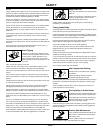
Safety - 7
SAFETY
machine.
• Tragic accidents with children can occur if the operator is not alert to the
presence of children, especially when a child approaches a machine from
behind. Before and while backing up, stop mower blades and look down
and behind the machine carefully, especially for children.
• Never carry children on a machine or attachment, even with the blades
off. Do not tow children in a cart or trailer. They can fall off and be seriously
injured or interfere with safe machine operation.
• Never use the machine as a recreational vehicle or to entertain children.
• Never allow children or an untrained person operate the machine.
Instruct all operators not to give children a ride on the machine or in an
attachment.
• Keep children indoors, out of the mowing area, and in the watchful eye of
a responsible adult, other than the operator, when a mower is being
operated.
• Stay alert to the presence of children. Never assume that children will
remain where you last saw them. Turn the machine off if a child enters the
work area.
• Use extreme care when approaching blind corners, shrubs, trees, or
other objects that may block your view of a child.
Avoid Tipping
• Slopes are a major factor related to loss-of-
control and tip-over accidents, which can result
in severe injury or death. Operation on all
slopes requires extra caution. If you cannot
back up the slope or if you feel uneasy on it, do
not mow it.
• Mow up and down slopes, not across.
• Watch for holes, ruts, bumps, rocks, or other hidden objects. Uneven
terrain could overturn the machine. Tall grass can hide obstacles.
• Choose a low ground speed so you will not have to stop or shift while on
a slope.
• Do not mow or operate machine on wet grass. Tires may lose traction.
Tires may lose traction on slopes even though the brakes are functioning
properly.
• Always keep the machine in gear when going down slopes. Do not shift
to neutral and coast downhill.
• Avoid starting, stopping or turning on a slope. If the tires lose traction,
disengage the blades and proceed slowly, straight down the slope.
• Keep all movement on slopes slow and gradual. Do not make sudden
changes in speed or direction, which could cause the machine to roll over.
• Use extra care while operating machine with grasscatchers or other
attachments, they can affect stability of the machine. Do not use on steep
slopes.
• Do not try to stabilize the machine by putting your foot on the ground.
• Do not mow near drop-offs, ditches, embankments, or bodies of water.
The machine could suddenly roll over if a wheel goes over the edge or the
edge caves in. Leave a safety area between the machine and any hazard.
• Follow the manufacturer’s recommendations for wheel weights or
counterweights for added stability when operating on slopes or using front
or rear mounted attachments. Remove weights when not required.
Keep Riders Off
• Only allow the operator on the machine. Keep
riders off.
• Riders on the machine or attachment may be
struck by foreign objects or thrown off the
machine causing serious injury.
• Riders obstruct the operator’s view resulting in the machine being
operated in an unsafe manner.
Towing Loads Safely
• Stopping distance increases with speed and weight of towed load. Travel
slowly and allow extra time and distance to stop.
• Total towed weight must not exceed combined weight of pulling machine,
ballast and operator. Use counterweights or wheel weights as described in
the attachment or pulling machine operator’s manual.
• Excessive towed load can cause loss of traction and loss of control on
slopes. Reduce towed weight when operating on slopes.
• Never allow children or others in or on towed equipment.
• Use only approved hitches. Tow only with a machine that has a hitch
designed for towing. Do not attach towed equipment except at the
approved hitch point.
• Follow the manufacturer’s recommendations for weight limits for towed
equipment and towing on slopes.
• If you cannot back up a slope with a towed load, the slope is too steep to
operate on with the towed load. Reduce the towed load or do not operate.
• Do not turn sharply. Use additional caution when turning or operating
under adverse surface conditions. Use care when reversing.
• Do not shift to neutral and coast downhill.
Wear Appropriate Clothing
• Always wear eye protection when operating
the machine.
• Wear close fitting clothing and safety
equipment appropriate for the job.
• While operating this machine, always wear substantial footwear and long
trousers. Do not operate the equipment when barefoot or wearing open
sandals.
• Wear a suitable protective device such as earplugs. Loud noise can
cause impairment or loss of hearing.
Driving Safely on Public Roads
Avoid personal injury or death resulting from a
collision with another vehicle on public roads:
• Use safety lights and devices. Slow moving
machines when driven on public roads are
hard to see, especially at night.
• Whenever driving on public roads, use flashing warning lights and turn
signals according to local regulations. Extra flashing warning lights may
need to be installed.
Practice Safe Maintenance
• Only qualified, trained adults should service
this machine. Understand service procedure
before doing work.
• Never operate machine in a closed area
where dangerous carbon monoxide fumes can collect.


















